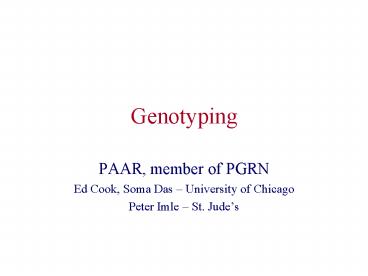Genotyping PowerPoint PPT Presentation
1 / 20
Title: Genotyping
1
Genotyping
- PAAR, member of PGRN
- Ed Cook, Soma Das University of Chicago
- Peter Imle St. Judes
2
Many SNP typing methods
- PCR-direct sequencing with Polyphred v 4 allele
calling (shorter sequencing pyrosequencing) - PCR-RFLP
- Allele-specific PCR (/- locked nucleic acids)
- Oligonucleotide ligation (OLA Nickerson)
- Includes bead array by Illumina for multiplexing
- Hybridization/quencher-TaqMan (SNPs on demand and
by design), Molecular Beacons - Primer extension (based on sequence, extension of
different length by ddNTP of specific
base)(Sequenom) - SBE (detection methods-FP,dHPLC,CE,tag array)
3
Single base extension (SBE)
- Detection methods
- Fluorescent polarization (FP-TDI)(? Cheapest SBE
method, but relatively low assay conversion rate) - dHPLC (? highest SBE conversion rate, can be
duplexed or more) - CE (SNaPshot)(can be pooled)
- Tag array (Orchid, Affymetrix, homegrown)(allows
high rate of multiplexing PCR and pooling SBE
products)
4
SNP Genotyping Advantages and Disadvantages
- Low cost per genotype and high throughput, but
only when running thousands of subjects per SNP
for a few SNPs - Availability of equipment (location-specific)
- Equipment without separation or scanning (e.g.
FP, TaqMan)(either may be run by LjL fluorescent
96-384 microplate reader) - Requirement (or not) of labeled primers or ddNTPs
(SBE-dHPLC) - Requirement of relatively expensive
reporter/quencher probes (TaqMan, Molecular
Beacons)(cost depends on numbers of samples to
genotype) - High conversion rate (e.g. OLA, SBE-dHPLC, ?
TaqMan) - Ease of typing (TaqMan, one reaction, one plate)
5
(No Transcript)
6
SBE-DHPLC
- Sample is amplified by PCR
- PCR product is purified by SAP and
- exoI to eliminate excess primers and
- dNTPs
- An extension reaction is done using a
- primer directly adjacent to the base in
- question and ddNTPs
- Only one base is added to the 3-end of
- the primer resulting in an extension
- product containing the SNP
- The samples are denatured and run
- on the DHPLC
- Extension products separate based on
- base content and hydrophobicity of
7
GENES ANALYSED BY SBE-DHPLC in Das lab
GENE POLYMORPHISM UGT2B7 -161T/C (promoter
SNP) VDR Ex8283G/A (intron 8
SNP) PGP/MDR1 2677G ? T (exon
21) PGP/MDR1 3435C ? T (exon 26) RFC 80G ?
A MTHFR Glu429Ala GSTP1 Ile105Val
8
RFC 80 G?A
C
9
RFC 80 G?A (R27H)
u.p.
C
T
A/A
G/A
A/A
G/G
G/G
Allele frequencies A 43.7 G 56.3
10
5
PCR reaction, when Taq extends over a hybridized
probe, 5 nuclease activity cleaves 5 base and
reporter dye is no longer quenched (U substituted
for T, so that UNGase will destroy any
contaminants with products from a previous assay)
11
Assay on Demand (TaqMan)
384 well microplate, 5 ul reaction volume, 6 ng
DNA, amplify 9600 mode on 9700, read same plate
as LJL HE384A
1 per genotype for 300 samples, 0.40 for 750
subjects core charge e.g. 22 assays for
EGFR, 17 of 21 intervals lt 11 kb (mean 8.8 kb)
12
TPH2 (new gene - ? assays)
- Walther DJ, et al. (2003) Synthesis of serotonin
by a second tryptophan hydroxylase isoform.
Science 29976 - AK094614
- Homo sapiens cDNA FLJ37295 fis, clone
BRAMY2015311, moderately similar to TRYPTOPHAN
5-MONOOXYGENASE (EC 1.14.16.4) - chr1272284699-72311212
- 12q21.1
- cM 83.19 markers flank it (Marshfield
sex-averaged) - Between D12S80 and D12S1040
- Celera Gene Name hCG25174
13
Search assays on demand (TPH2)
- https//abassays.celera.com/cdsEntry/Marketing/snp
_overview.jsp
14
SNPs that have to be typed Algorithm (subject to
change)
- A) Genotyping
- 1) FP-TDI (lt 200 samples or no TaqMan assay)
- 2) TaqMan (gt 200 samples and available)
- 2) SBE-dHPLC
- 3) Whatever works, but cost probably increased
(molecular beacon, OLA,PCR-RFLP,)
15
SNP typing approach (continued)
- B) QC (Mendelian, double-recombinant, HWE
checks) - 1) should 2 or more methods with non-overlapping
primers be used to be sure no errors? SNPs in
primersif association negative if positive? - 2) should allele calling images (sequence traces)
be part of PAAR (and PGRN) network data - 3) is ability to reduce errors of SBE-dHPLC a
significant advantage for triallelic SNPs?
16
Dense SNP coverage of a region
- More efficient when every SNP doesnt have to be
typed (to allow choosing one or two methods and
automating them) - Assays on demand (TaqMan) focused on genes
- Other approaches to selecting and typing other
SNPs (e.g. FP-TDI)
17
Other Adventures in SNP Typing
- Outsourcing (Adventures in purchasing?)
- Illumina pricing based on large number of SNPs
(e.g. 1152) - Sequenom (better for a large number of SNPs)
- DNAprint (Orchid)(some concerns about one of
homozygote clusters overlapping negatives)
18
Pooling?
- Pooling (sequenom, SNaPshot, dHPLC,
pyrosequencing, direct sequencing)(probably not
Orchid arrays or Affy flex arrays)
19
Length Variants
- Microsatellites, small insertion/deletions
- Relatively straightforward with end-labeled
primers and capillary electrophoresis instruments
(e.g. 3100,3700, 3730) - Can be relatively easily multiplexed (for PCR)
and pooled (for injection) with up to 20 markers
(with up to 5 fluorescent dyes) - Genome scans available locally (e.g. U Chicago)
or through CIDR, NHLBI, DeCODE - SNP genome scans
- Affy (now gt10K, 100K planned for 2004)
20
Whole Genome Analysis
- Affymetrix Human Mapping 10K XbaI
- 11,560 SNPs spanning the genome
- Average heterozygosity 33
- Preliminary Results
- 90-95 call rate
- Straightforward Assay
- Automated allele calling (in contrast to
microsatellite allele calling)

